Optimization of Microalga Chlorella vulgaris Magnetic Harvesting
Abstract
1. Introduction
2. Materials and Methods
2.1. Chemical Reagents
2.2. Microwave Synthesis of Magnetite (Fe3O4) Particles
2.3. Microalgal Strain and Cultivation
2.4. Characterization of Fe3O4 Particles and Microalgae
2.4.1. X-ray Diffraction of Magnetite Particles and Magnetic Properties
2.4.2. Observation with Scanning Electron Microscopy Coupled with Energy Dispersive X-ray Spectroscopy (SEM-EDS)
2.4.3. Microalgae Analysis
2.4.4. Zeta Potential Measurements
2.5. C. vulgaris Magnetic Harvesting Using Fe3O4 Particles
2.5.1. Magnetic Harvesting Experimental Procedure
2.5.2. Effect of Harvesting Process Parameters on Microalgae Magnetic Harvesting Using Fe3O4 Particles
2.5.3. Experimental Design for Optimization of C. vulgaris Harvesting Using the Response Surface Methodology
2.5.4. Adsorption Isotherms
2.5.5. Reusability of Magnetic Particles
2.6. Statistical Analysis
2.7. Cell Membrane Integrity of C. vulgaris Cells
3. Results and Discussion
3.1. Characterization of Fe3O4 Particles
3.2. Algae Harvesting Efficiency Optimization
3.2.1. Characterization of C. vulgaris and Magnetic Particles Interaction Using SEM
3.2.2. Magnetic Harvesting of C. vulgaris
3.3. Separation Mechanism
3.4. Adsorption Isotherms
3.5. Regeneration and Reusability of Fe3O4 Particles
4. Conclusions
Author Contributions
Funding
Institutional Review Board Statement
Informed Consent Statement
Data Availability Statement
Acknowledgments
Conflicts of Interest
References
- Khan, M.I.; Shin, J.H.; Kim, J.D. The promising future of microalgae: Current status, challenges and optimization of a sustainable and renewable industry for biofuels, feed, and other products. Microb. Cell Fact. 2018, 17, 36. [Google Scholar] [CrossRef] [PubMed]
- Sharma, R.K.; Saharia, M.; Srivstava, R.; Kumar, S.; Sahoo, L. Tailoring microalgae for efficient biofuel production. Front. Mar. Sci. 2018, 5, 382. [Google Scholar] [CrossRef]
- Hossain, N.; Mahlia, T.M.I.; Saidur, R. Latest development in microalgae-biofuel production with nano-additives. Biotechnol. Biofuels 2019, 12, 125. [Google Scholar] [CrossRef] [PubMed]
- Novoveská, L.; Ross, M.E.; Stanley, M.S.; Pradelles, R.; Wasiolek, V.; Sassi, J.-F. Microalgal Carotenoids: A Review of Production, Current Markets, Regulations, and Future Direction. Mar. Drugs 2019, 17, 640. [Google Scholar] [CrossRef] [PubMed]
- Gouveia, L.; Oliveira, A.C. Microalgae as a raw material for biofuels production. J. Ind. Microbiol. Biotechnol. 2009, 36, 269–274. [Google Scholar] [CrossRef]
- Clarens, A.F.; Resurreccion, E.P.; White, M.A.; Colost, L.M. Environmental life cycle comparison of algae to other bioenergy feedstocks. Environ. Sci. Technol. 2010, 44, 1813–1819. [Google Scholar] [CrossRef]
- Coons, J.E.; Kalb, D.M.; Dale, T.; Marrone, B.L. Getting to low-cost algal biofuels: A monograph on conventional and cutting-edge harvesting and extraction technologies. Algal Res. 2014, 6 Pt B, 250–270. [Google Scholar] [CrossRef]
- Sharma, K.K.; Garg, S.; Li, Y.; Malekizadeh, A.; Schenk, P.M. Critical analysis of current microalgae dewatering techniques. Biofuels 2013, 4, 397–407. [Google Scholar] [CrossRef]
- Zhu, L.-D.; Hiltunen, E.; Li, Z. Using magnetic materials to harvest microalgal biomass: Evaluation of harvesting and detachment efficiency. Environ. Technol. 2019, 40, 1006–1012. [Google Scholar] [CrossRef]
- Milledge, J.J.; Heaven, S. A review of the harvesting of micro-algae for biofuel production. Rev. Environ. Sci. Biotechnol. 2013, 12, 165–178. [Google Scholar] [CrossRef]
- Molina Grima, E.; Belarbi, E.H.; Acién Fernández, F.G.; Robles Medina, A.; Chisti, Y. Recovery of microalgal biomass and metabolites: Process options and economics. Biotechnol. Adv. 2003, 20, 491–515. [Google Scholar] [CrossRef]
- Bharte, S.; Desai, K. Harvesting Chlorella species using magnetic iron oxide nanoparticles. Psychol. Res. 2019, 67, 128–133. [Google Scholar] [CrossRef]
- Papazi, A.; Makridis, P.; Divanach, P. Harvesting Chlorella minutissima using cell coagulants. J. Appl. Phycol. 2010, 22, 349–355. [Google Scholar] [CrossRef]
- Chen, L.; Wang, C.; Wang, W.; Wei, J. Optimal conditions of different flocculation methods for harvesting Scenedesmus sp. cultivated in an open-pond system. Bioresour. Technol. 2013, 133, 9–15. [Google Scholar] [CrossRef] [PubMed]
- Xu, Y.; Purton, S.; Baganz, F. Chitosan flocculation to aid the harvesting of the microalga Chlorella sorokiniana. Bioresour. Technol. 2013, 129, 296–301. [Google Scholar] [CrossRef] [PubMed]
- Matter, A.I.; Bui, V.K.H.; Jung, M.; Seo, J.Y.; Kim, Y.-E.; Lee, Y.-C.; Oh, Y.-K. Flocculation Harvesting Techniques for Microalgae: A Review. Appl. Sci. 2019, 9, 3069. [Google Scholar] [CrossRef]
- Borlido, L.; Azevedo, A.M.; Roque, A.C.A.; Aires-Barros, M.R. Magnetic separations in biotechnology. Biotechnol. Adv. 2013, 31, 1374–1385. [Google Scholar] [CrossRef]
- Yavuz, C.T.; Prakash, A.; Mayo, J.T.; Colvin, V.L. Magnetic separations: From steel plants to biotechnology. Chem. Eng. Sci. 2009, 64, 2510–2521. [Google Scholar] [CrossRef]
- Almomani, F. Algal cells harvesting using cost-effective magnetic nano-particles. Sci. Total Environ. 2020, 720, 137621. [Google Scholar] [CrossRef]
- Boli, E.; Savvidou, M.; Logothetis, D.; Louli, V.; Pappa, G.; Voutsas, E.; Kolisis, F.; Magoulas, K. Magnetic harvesting of marine algae Nannochloropsis oceanica. Sep. Sci. Technol. 2017, 6395, 1–8. [Google Scholar] [CrossRef]
- Gerulová, K.; Bartošová, A.; Blinová, L.; Bártová, K.; Dománková, M.; Garaiová, Z.; Palcut, M. Magnetic Fe3O4-polyethyleneimine nanocomposites for efficient harvesting of Chlorella zofingiensis, Chlorella vulgaris, Chlorella sorokiniana, Chlorella ellipsoidea and Botryococcus braunii. Algal Res. 2018, 33, 165–172. [Google Scholar] [CrossRef]
- Savvidou, M.G.; Boli, E.; Logothetis, D.; Lymperopoulou, T.; Ferraro, A.; Louli, V.; Mamma, D.; Kekos, D.; Magoulas, K.; Kolisis, F.N. A Study on the Effect of Macro-and Micro-Nutrients on Nannochloropsis oceanica Growth, Fatty Acid Composition and Magnetic Harvesting Efficiency. Plants 2020, 9, 660. [Google Scholar] [CrossRef] [PubMed]
- Taghizadeh, S.M.; Berenjian, A.; Chew, K.W.; Show, P.L.; Mohd Zaid, H.F.; Ramezani, H.; Ghasemi, Y.; Raee, M.J.; Ebrahiminezhad, A. Impact of magnetic immobilization on the cell physiology of green unicellular algae Chlorella vulgaris. Bioengineered 2020, 11, 141–153. [Google Scholar] [CrossRef]
- Eroglu, E.; Agarwal, V.; Bradshaw, M.; Chen, X.; Smith, S.M.; Raston, C.L.; Swaminathan Iyer, K. Nitrate removal from liquid effluents using microalgae immobilized on chitosan nanofiber mats. Green Chem. 2012, 14, 2682–2685. [Google Scholar] [CrossRef]
- Hu, Y.R.; Guo, C.; Wang, F.; Wang, S.K.; Pan, F.; Liu, C.Z. Improvement of microalgae harvesting by magnetic nanocomposites coated with polyethylenimine. Chem. Eng. J. 2014, 242, 341–347. [Google Scholar] [CrossRef]
- Prochazkova, G.; Podolova, N.; Safarik, I.; Zachleder, V.; Branyik, T. Physicochemical approach to freshwater microalgae harvesting with magnetic particles. Colloids Surf. B Biointerfaces 2013, 112, 213–218. [Google Scholar] [CrossRef] [PubMed]
- Prochazkova, G.; Safarik, I.; Branyik, T. Harvesting microalgae with microwave synthesized magnetic microparticles. Bioresour. Technol. 2013, 130, 472–477. [Google Scholar] [CrossRef]
- Xu, L.; Guo, C.; Wang, F.; Zheng, S.; Liu, C.Z. A simple and rapid harvesting method for microalgae by in situ magnetic separation. Bioresour. Technol. 2011, 102, 10047–10051. [Google Scholar] [CrossRef]
- Fraga-Garcia, P.; Kubbutat, P.; Brammen, M.; Schwaminger, S.; Berensmeier, S. Bare iron oxide nanoparticles for magnetic harvesting of microlagae: From interaction behavior to process realization. Nanomaterials 2018, 8, 292. [Google Scholar] [CrossRef]
- Franzreb, M.; Siemann-Herzberg, M.; Hobley, T.J.; Thomas, O.R.T. Protein purification using magnetic adsorbent particles. Appl. Microbiol. Biotechnol. 2006, 70, 505–516. [Google Scholar] [CrossRef]
- Sharma, R. Effects of Culture Conditions on Growth and Biochemical Profile of Chlorella Vulgaris. J. Plant Pathol. Microbiol. 2012, 3, 1000131. [Google Scholar] [CrossRef]
- Zhang, R.; Chen, J.; Mao, X.; Qi, P.; Zhang, X. Anti-inflammatory and anti-aging evaluation of pigment-protein complex extracted from Chlorella Pyrenoidosa. Mar. Drugs 2019, 17, 586. [Google Scholar] [CrossRef]
- Shibata, S.; Natori, Y.; Nishihara, T.; Tomisaka, K.; Matsumoto, K.; Sansawa, H. Antioxidant and Anti-Cataract Effects of Chlorella on Rats with Streptozotocin-Induced Diabetes. J. Nutr. Sci. Vitaminol. 2003, 49, 334–339. [Google Scholar] [CrossRef]
- Ishiguro, S.; Robben, N.; Burghart, R.; Cote, P.; Greenway, S.; Thakkar, R.; Upreti, D.; Nakashima, A.; Suzuki, K.; Comer, J.; et al. Cell wall membrane fraction of Chlorella sorokiniana enhances hot antitumor immunity and inhbits colon carcinoma growth in mice. Integr. Cell Ther. 2020, 19, 1–10. [Google Scholar]
- Belasco, W. Algae burgers for a hungry world? The rise and fall of chlorella cuisine. Technol. Cult. 1997, 38, 608–634. [Google Scholar] [CrossRef]
- Rani, K.; Sandal, N.; Sahoo, P.K. A comprehensive review on chlorella-its composition, health benefits, market and regulatory scenario. J. Pharm. Innov. 2018, 7, 584–589. [Google Scholar]
- Dardavila, M.M.; Hamilakis, S.; Loizos, Z.; Kollia, C. Ni/ZrO2 composite electrodeposition in the presence of coumarin: Textural modifications and properties. J. Appl. Electrochem. 2015, 45, 503–514. [Google Scholar] [CrossRef]
- Markeb, A.A.; Llimós-Turet, J.; Ferrer, I.; Blánquez, P.; Alonso, A.; Sánchez, A.; Moral-Vico, J.; Font, X. The use of magnetic iron oxide based nanoparticles to improve microalgae harvesting in real wastewater. Water Res. 2019, 159, 490–500. [Google Scholar] [CrossRef]
- Aivazoglou, E.; Metaxa, E.; Hristoforou, E. Microwave-assisted synthesis of iron oxide nanoparticles in biocompatible organic environment. AIP Adv. 2018, 8, 048201. [Google Scholar] [CrossRef]
- Leite, L.D.S.; Daniel, L.A. Optimization of microalgae harvesting by sedimentation induced by high pH. Water Sci. Technol. 2020, 82, 1227–1236. [Google Scholar] [CrossRef]
- Zhao, Y.; Liang, W.; Liu, L.; Li, F.; Fan, Q.; Sun, X. Harvesting Chlorella vulgaris by magnetic flocculation using Fe3O4 coating with polyaluminium chloride and polyacrylamide. Bioresour. Technol. 2015, 198, 789–796. [Google Scholar] [CrossRef]
- Tork, M.B.; Khalilzadeh, R.; Kouchakzadeh, H. Efficient harvesting of marine Chlorella vulgaris microalgae utilizing cationic starch nanoparticles by response surface methodology. Bioresour. Technol. 2017, 243, 583–588. [Google Scholar] [CrossRef] [PubMed]
- Fayad, N.; Yehya, T.; Audonnet, F.; Vial, C. Harvesting of microalgae Chlorella vulgaris using electro-coagulation-flocculation in the batch mode. Algal Res. 2017, 25, 1–11. [Google Scholar] [CrossRef]
- Liu, Y.; Jin, W.; Zhou, X.; Han, S.F.; Tu, R.; Feng, X.; Wang, Q. Efficient harvesting of Chlorella pyrenoidosa and Scenedesmus obliquus cultivated in urban sewage by magnetic flocculation using nano-Fe3O4 coated with polyethyleneimine. Bioresour. Technol. 2019, 290, 121771. [Google Scholar] [CrossRef]
- Razack, S.A.; Duraiarasan, S.; Shellomith, A.S.; Muralikrishnan, K. Statistical optimization of harvesting Chlorella vulgaris using a novel bio-source, Strychnos potatorum. Biotechnol. Rep. 2015, 7, 150–156. [Google Scholar] [CrossRef]
- Zhao, Y.; Fan, Q.; Wang, X.; Jiang, X.; Jiao, L.; Liang, W. Application of Fe3O4 coated with modified plant polyphenol to harvest oleaginous microalgae. Algal Res. 2019, 38, 101417. [Google Scholar] [CrossRef]
- Wang, T.; Yang, W.L.; Hong, Y.; Hou, Y.L. Magnetic nanoparticles grafted with amino-riched dendrimer as magnetic flocculant for efficient harvesting of oleaginous microalgae. Chem. Eng. J. 2016, 297, 304–314. [Google Scholar] [CrossRef]
- Wang, X.; Zhao, Y.; Jiang, X.; Liu, L.; Li, X.; Li, H.; Liang, W. In-situ self-assembly of plant polyphenol-coated Fe3O4 particles for oleaginous microalgae harvesting. J. Environ. Manag. 2018, 214, 335–345. [Google Scholar] [CrossRef]
- Hu, Y.R.; Wang, F.; Wang, S.K.; Liu, C.Z.; Guo, C. Efficient harvesting of marine microalgae Nannochloropsis maritima using magnetic nanoparticles. Bioresour. Technol. 2013, 138, 387–390. [Google Scholar] [CrossRef]
- Li, Y.G.; Gao, H.S.; Li, W.L.; Xing, J.M.; Liu, H.Z. In situ magnetic separation and immobilization of dibenzothiophene-desulfurizing bacteria. Bioresour. Technol. 2009, 100, 5092–5096. [Google Scholar] [CrossRef]
- Lin, Z.; Xu, Y.; Zhen, Z.; Fu, Y.; Liu, Y.; Li, W.; Zhang, D. Application and reactivation of magnetic nanoparticles in Microcystis aeruginosa harvesting. Bioresour. Technol. 2015, 190, 82–88. [Google Scholar] [CrossRef] [PubMed]
- Xu, Y.; Wang, X.; Fu, Y.; Hu, F.; Qian, G.; Liu, Q.; Sun, Y. Interaction energy and detachment of magnetic nanoparticles-algae. Environ. Sci. Technol. 2020, 41, 2618–2624. [Google Scholar] [CrossRef] [PubMed]
- Hena, S.; Fatihah, N.; Tabassum, S.; Lalung, J.; Jing, S.Y. Magnetophoretic harvesting of freshwater microalgae using polypyrrole/Fe3O4 nanocomposite and its reusability. J. Appl. Phycol. 2016, 28, 1597–1609. [Google Scholar] [CrossRef]
- Seo, J.Y.; Praveenkumar, R.; Kim, B.; Seo, J.-C.; Na, J.-G.; Seo, J.C.; Park, J.-Y.; Na, J.-G.; Jeon, S.G.; Park, S.B.; et al. Downstream integration of microalgae harvesting and cell disruption by means of cationic surfactant-decorated Fe3O4 nanoparticles. Green Chem. 2016, 18, 3981–3989. [Google Scholar] [CrossRef]
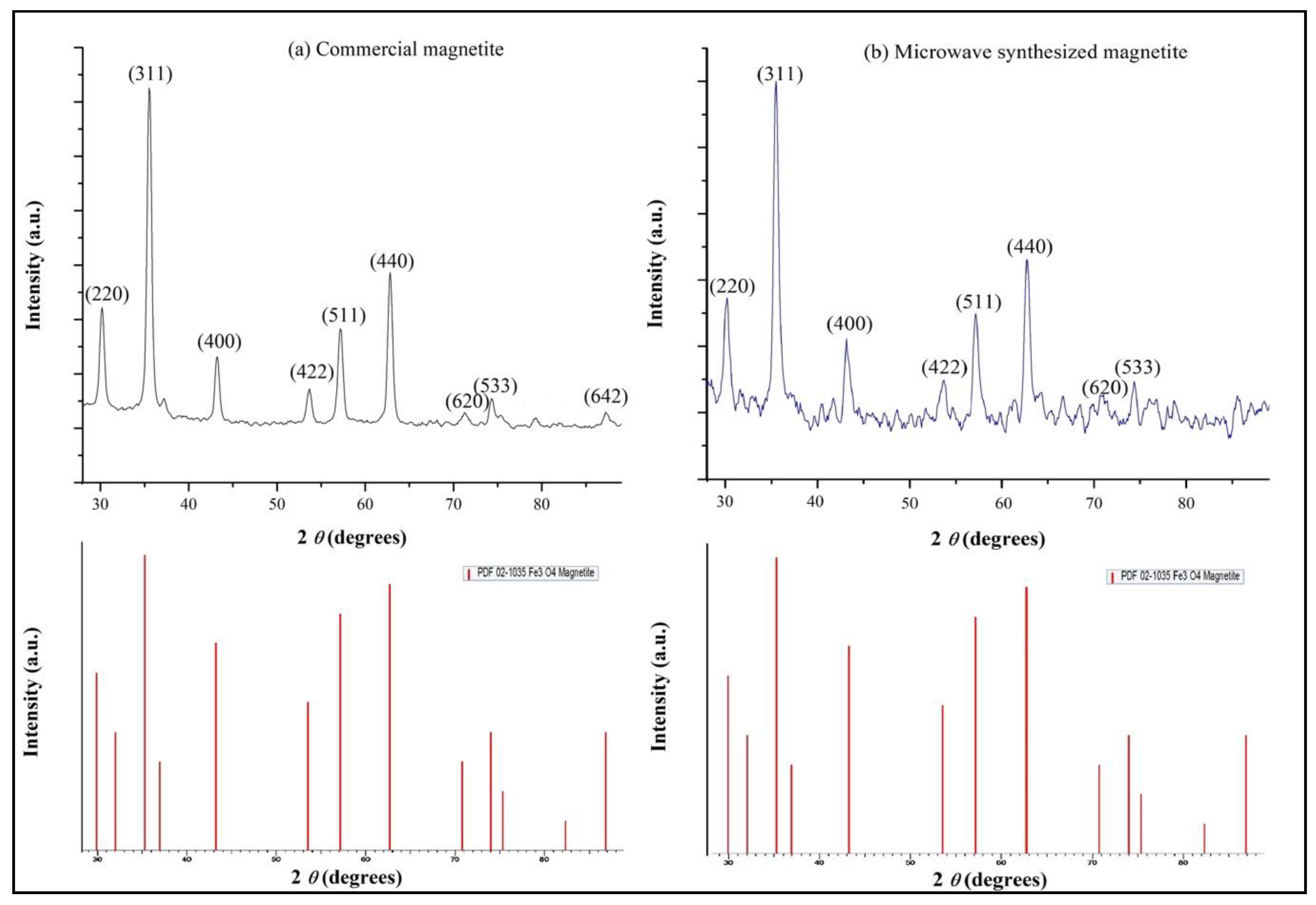
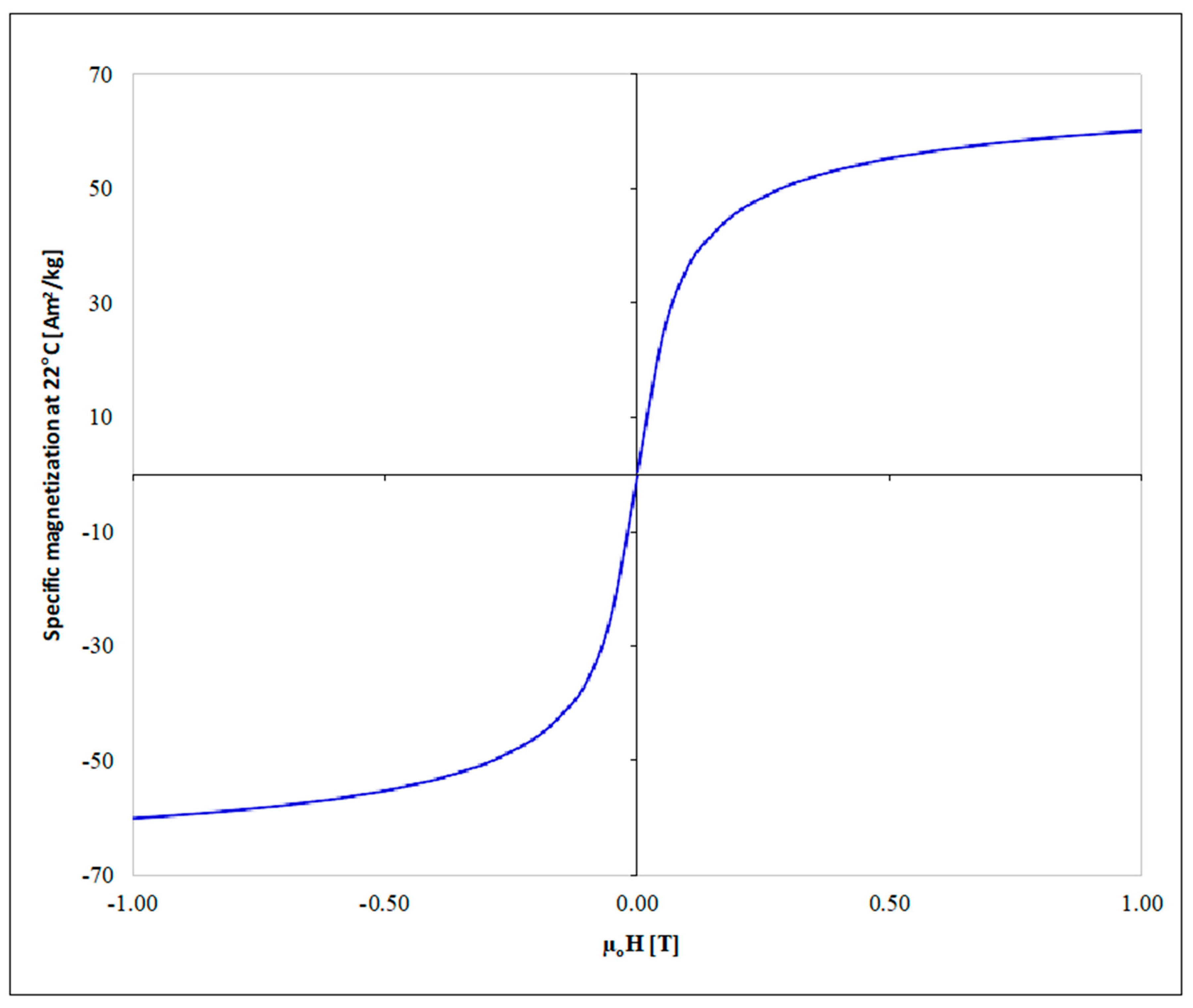
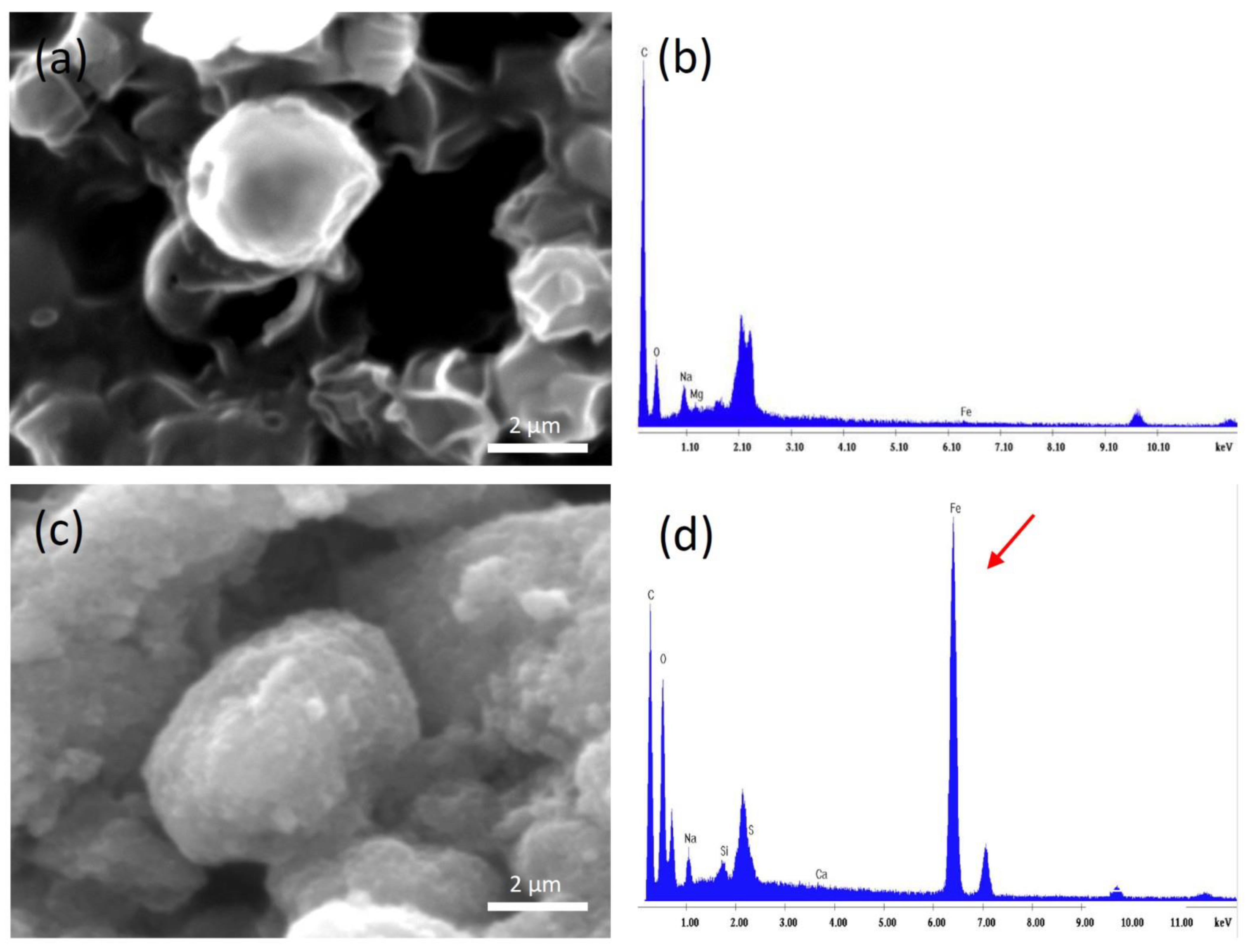
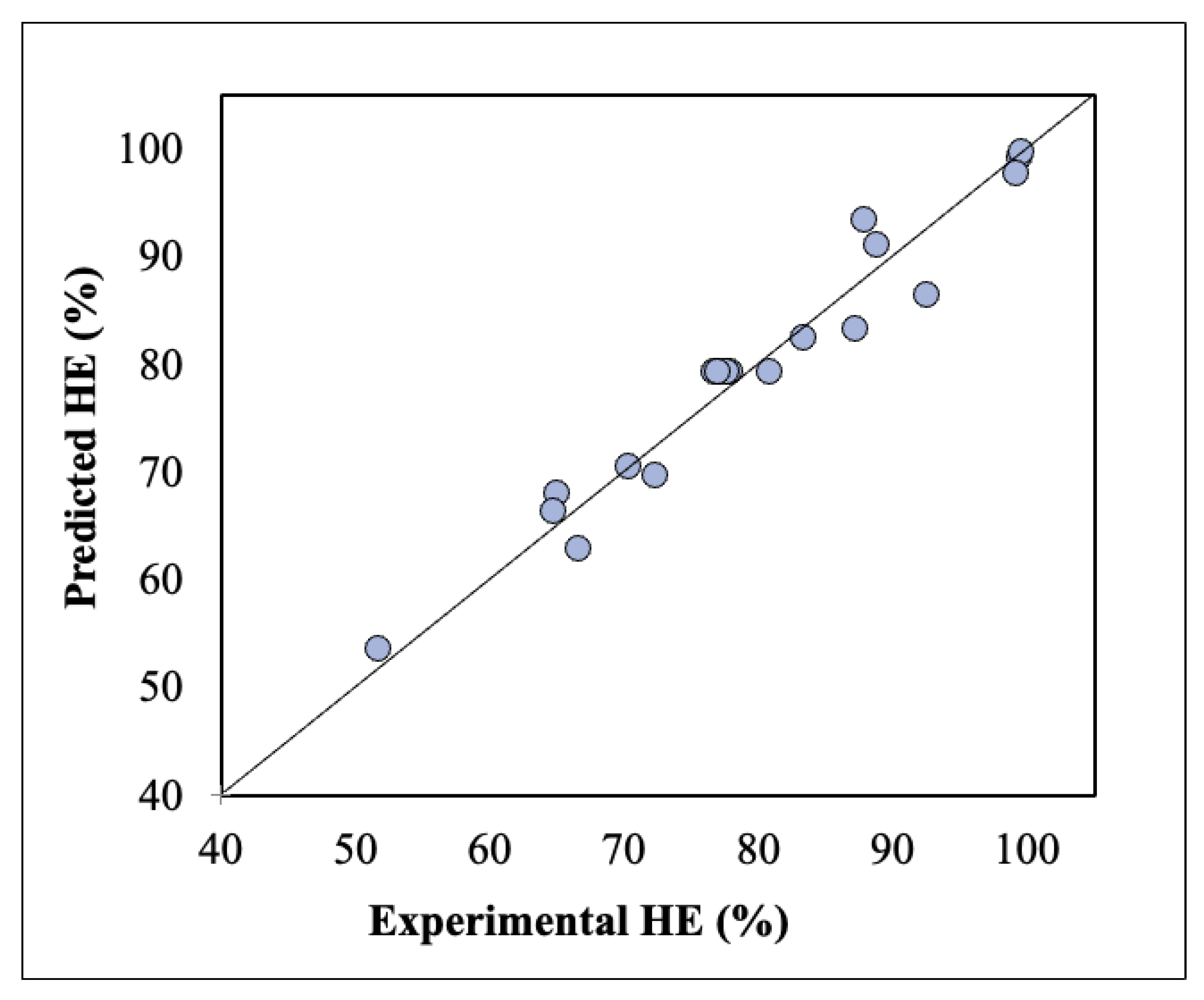
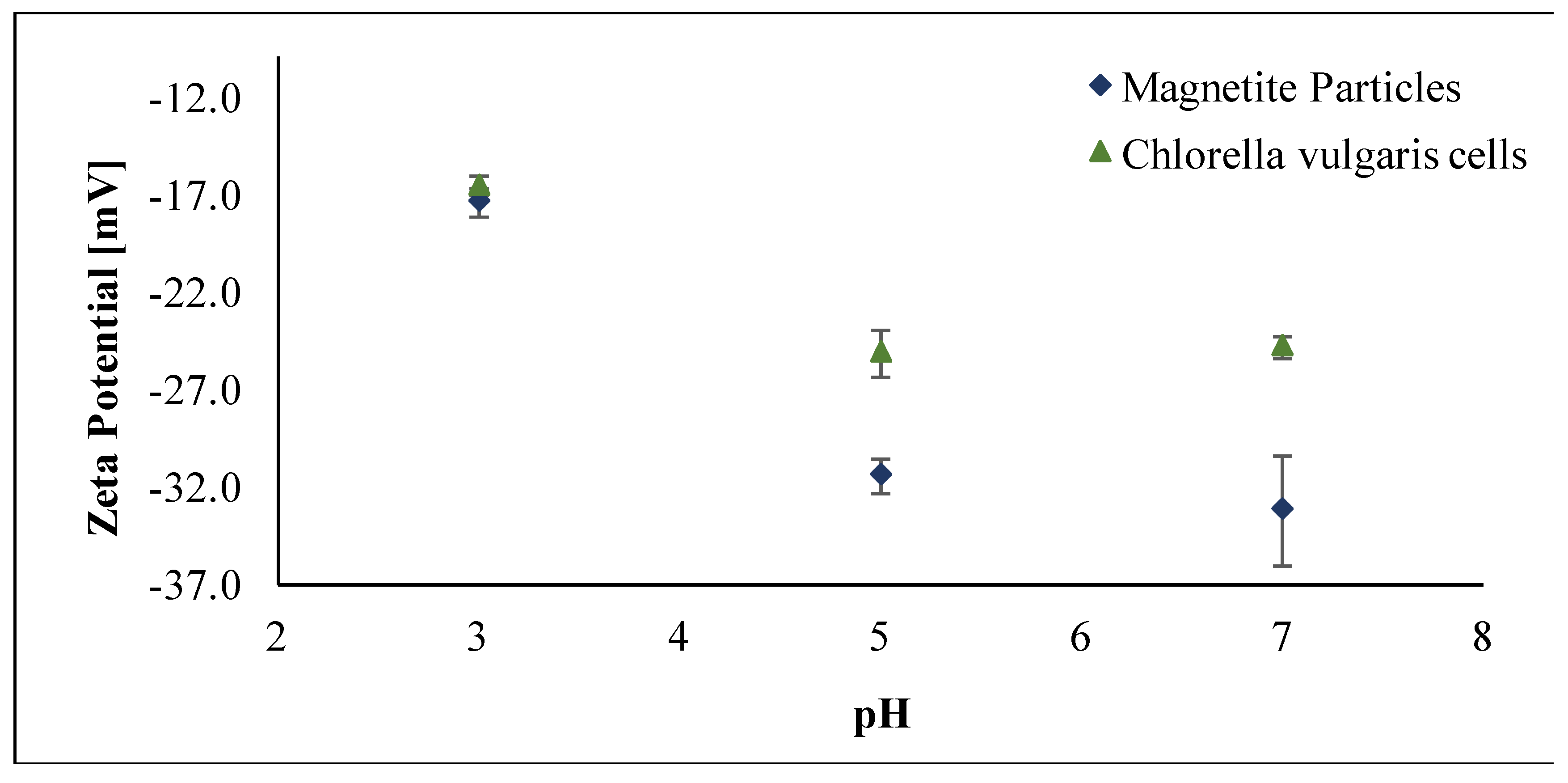
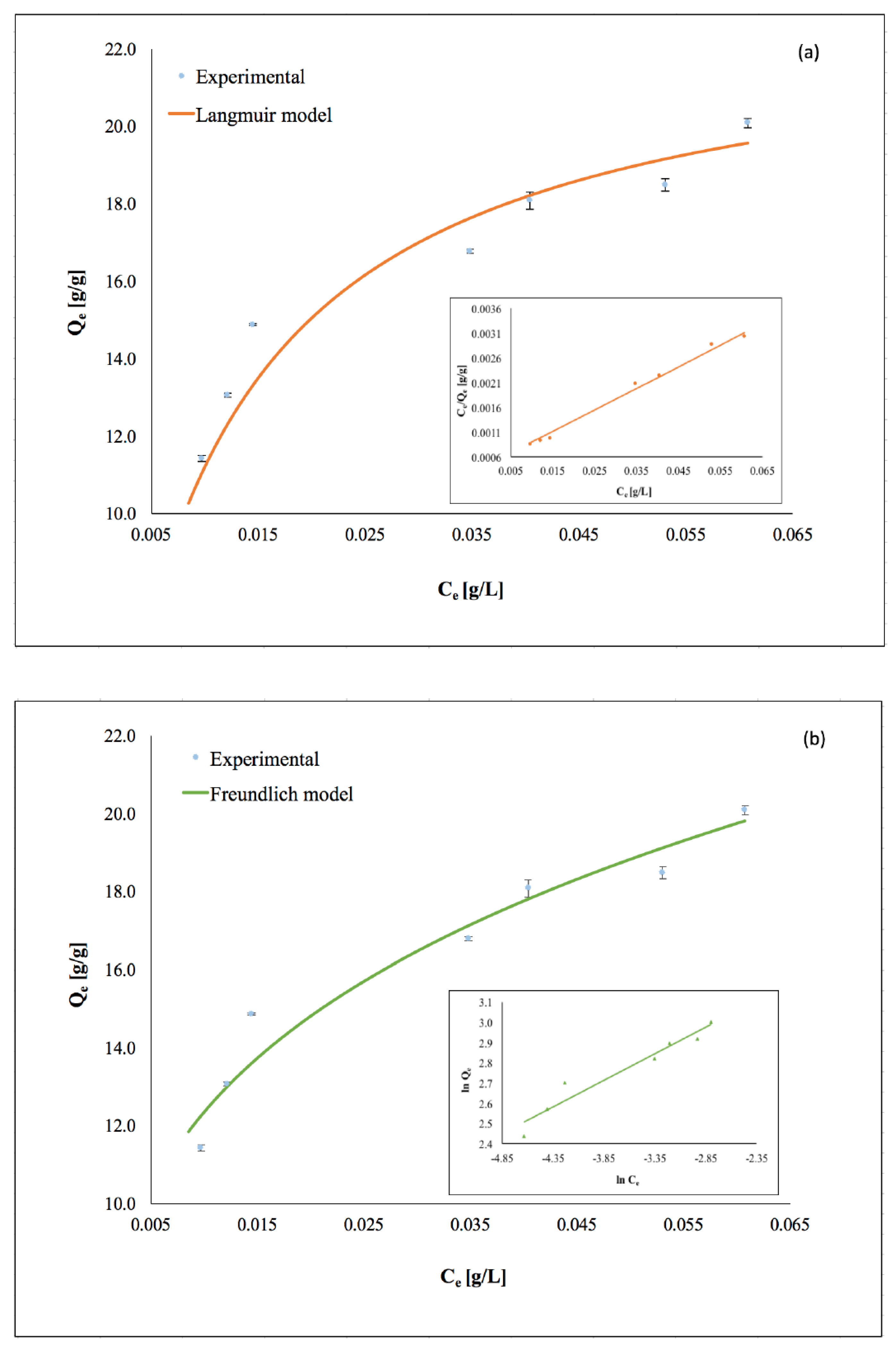
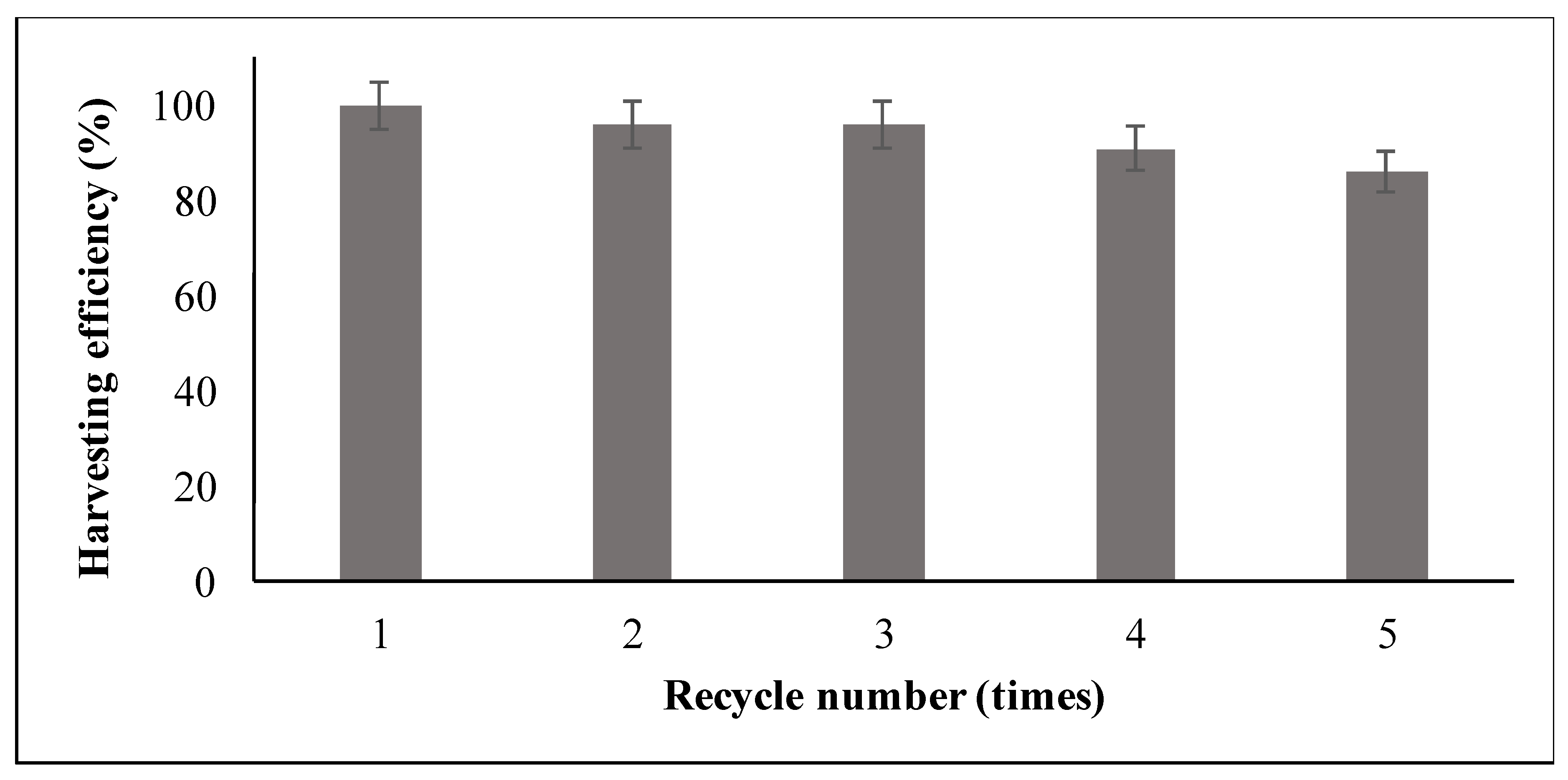
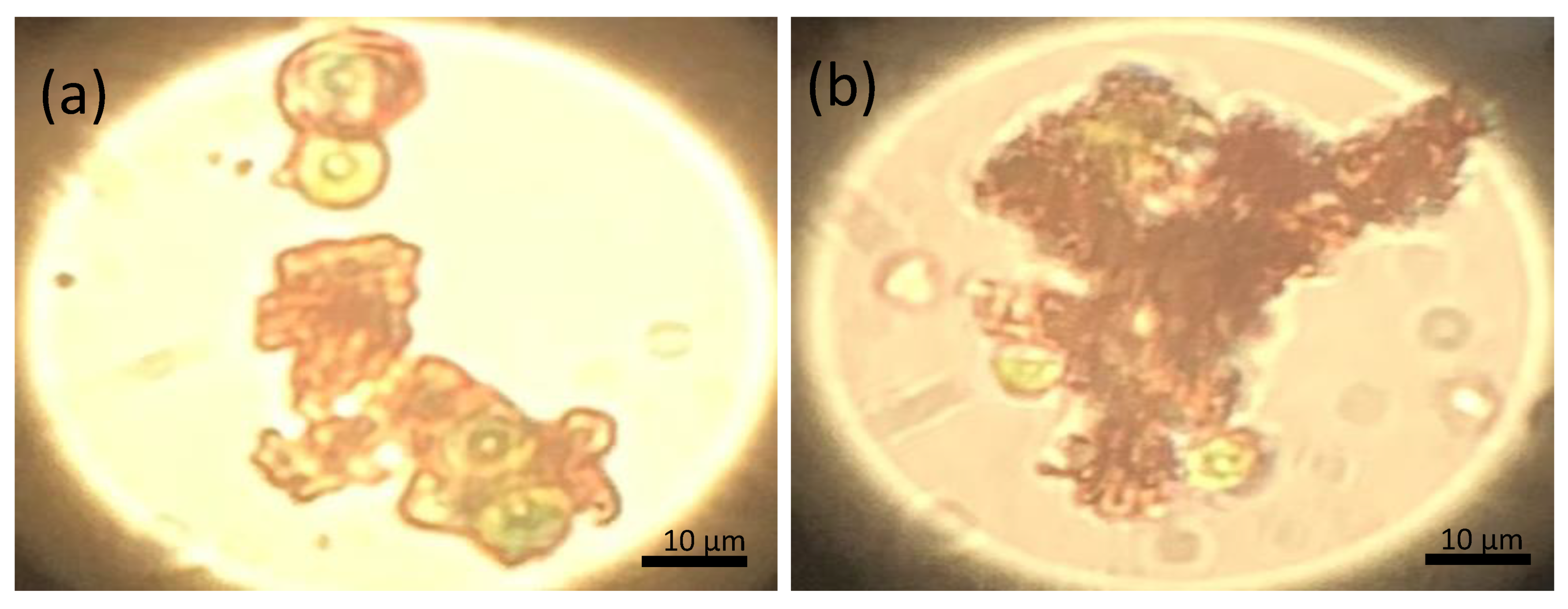
| Variables | Level −1 | Level 0 | Level +1 |
|---|---|---|---|
| pH | 3 | 5 | 7 |
| mass ratio (gmagn./gbiomass) | 10 | 12 | 14 |
| agitation speed (rpm) | 250 | 350 | 450 |
| Run | pH | Mass Ratio | Agitation Speed (rpm) | Measured Harvesting Efficiency (%) |
|---|---|---|---|---|
| 1 | 7 | 10:1 | 450 | 64.7 |
| 2 | 3 | 14:1 | 450 | 99.6 |
| 3 | 3 | 10:1 | 250 | 83.3 |
| 4 | 7 | 14:1 | 250 | 72.3 |
| 5 | 7 | 14:1 | 450 | 87.2 |
| 6 | 7 | 10:1 | 250 | 51.7 |
| 7 | 3 | 10:1 | 450 | 99.4 |
| 8 | 3 | 14:1 | 250 | 87.8 |
| 9 | 5 | 12:1 | 350 | 76.9 |
| 10 | 3 | 12:1 | 350 | 99.2 |
| 11 | 5 | 12:1 | 450 | 88.8 |
| 12 | 5 | 12:1 | 250 | 66.5 |
| 13 | 7 | 12:1 | 350 | 65.0 |
| 14 | 5 | 12:1 | 350 | 76.7 |
| 15 | 5 | 10:1 | 350 | 70.3 |
| 16 | 5 | 12:1 | 350 | 77.9 |
| 17 | 5 | 14:1 | 350 | 92.5 |
| 18 | 5 | 12:1 | 350 | 80.8 |
| 19 | 5 | 12:1 | 350 | 77.6 |
| 20 | 5 | 12:1 | 350 | 77.1 |
| Source | Sum of Squares | df | Mean | F-Value | p-Value |
|---|---|---|---|---|---|
| Square | Prob > F | ||||
| Model | 51.99 | 5 | 10.40 | 47.58 | <0.0001 |
| A-pH | 28.47 | 1 | 28.47 | 130.29 | <0.0001 |
| B-mass ratio | 3.58 | 1 | 3.58 | 16.37 | 0.0012 |
| C-agitation speed | 12.54 | 1 | 12.54 | 57.39 | <0.0001 |
| AC | 3.21 | 1 | 3.21 | 14.69 | 0.0018 |
| A2 | 4.19 | 1 | 4.19 | 19.15 | 0.0006 |
| Residual | 3.06 | 14 | 0.22 | ||
| Std. Dev. | 0.47 | R2 | 0.94 | ||
| Mean | 1.1 | Adj R2 | 0.93 | ||
| C.V. % | 42.52 | Pred R2 | 0.86 | ||
| PRESS | 7.96 | Adeq Precision | 26.60 |
| Langmuir Model | Freundlich Model | ||||
|---|---|---|---|---|---|
| Qm [g g−1] | Kl [L g−1] | R2 | Kf [g g−1] | nf | R2 |
| 22.95 | 95.10 | 0.99 | 41.30 | 3.81 | 0.94 |
Publisher’s Note: MDPI stays neutral with regard to jurisdictional claims in published maps and institutional affiliations. |
© 2021 by the authors. Licensee MDPI, Basel, Switzerland. This article is an open access article distributed under the terms and conditions of the Creative Commons Attribution (CC BY) license (https://creativecommons.org/licenses/by/4.0/).
Share and Cite
Savvidou, M.G.; Dardavila, M.M.; Georgiopoulou, I.; Louli, V.; Stamatis, H.; Kekos, D.; Voutsas, E. Optimization of Microalga Chlorella vulgaris Magnetic Harvesting. Nanomaterials 2021, 11, 1614. https://doi.org/10.3390/nano11061614
Savvidou MG, Dardavila MM, Georgiopoulou I, Louli V, Stamatis H, Kekos D, Voutsas E. Optimization of Microalga Chlorella vulgaris Magnetic Harvesting. Nanomaterials. 2021; 11(6):1614. https://doi.org/10.3390/nano11061614
Chicago/Turabian StyleSavvidou, Maria G., Maria Myrto Dardavila, Ioulia Georgiopoulou, Vasiliki Louli, Haralambos Stamatis, Dimitris Kekos, and Epaminondas Voutsas. 2021. "Optimization of Microalga Chlorella vulgaris Magnetic Harvesting" Nanomaterials 11, no. 6: 1614. https://doi.org/10.3390/nano11061614
APA StyleSavvidou, M. G., Dardavila, M. M., Georgiopoulou, I., Louli, V., Stamatis, H., Kekos, D., & Voutsas, E. (2021). Optimization of Microalga Chlorella vulgaris Magnetic Harvesting. Nanomaterials, 11(6), 1614. https://doi.org/10.3390/nano11061614






_Stamatis.png)

